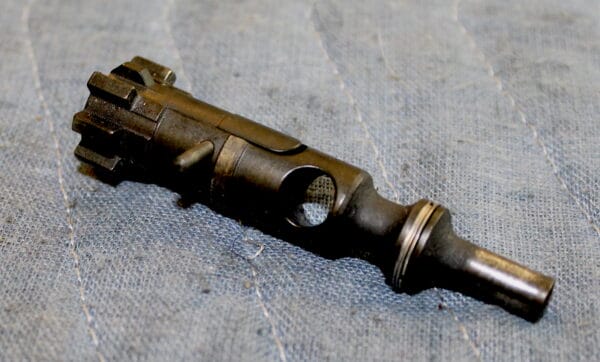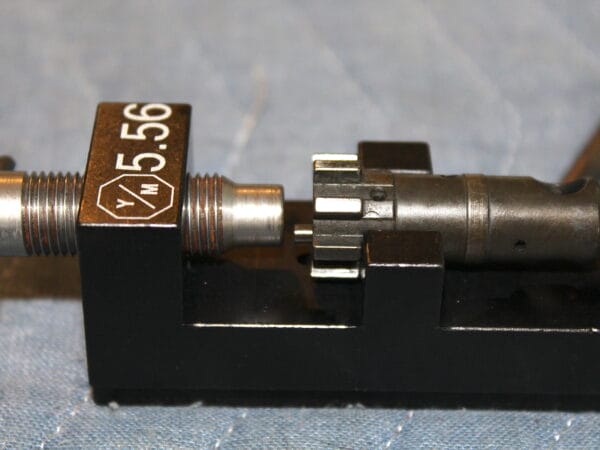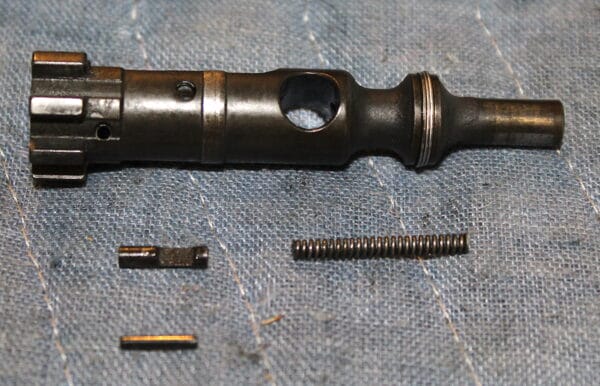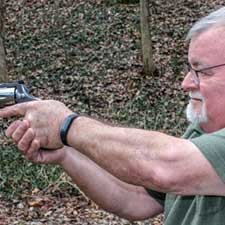The AR-15 rifle has certainly taken off from its humble beginnings. It is the most popular rifle among law-abiding gun owners in the United States. I won’t go into all the history, etc., of this rifle — we all know how it came to be. This article concerns maintenance, in particular, the ejector. Should the ejector be regularly replaced, and if so, at what round count?
The AR-15 Bolt
The AR-15 bolt is a marvel of engineering. When locked into the chamber, eight lugs contain the 53,000 psi pressure that the 5.56mm cartridge generates. The firing pin, extractor, and ejector work together to ensure proper functioning. But what about maintenance? Should you routinely replace parts?
Maintenance should be performed as required on an AR-15. During routine cleaning, you should check for wear on springs and parts. If an issue presents itself, you should identify the cause and replace the parts. This is not a 1-to-1 equation; you will have to assess what is going on with your rifle. Below are some examples of what a malfunctioning extractor or ejector would look like.
Extractor Problems
I would venture a guess that, of the two parts, the extractor is more likely to cause more problems than the ejector. Wrong spring tension (or flat-out wrong spring), worn claw… there are a few reasons to keep an eye on your extractor. Look at the fired cases as they come out of the gun, particularly their rims. Are they misshapen, or have chunks taken out? If cases are dinged badly, you might want to examine your extractor.
Ejector Issues
How can you tell if you have an issue with your ejector? There are a few things to watch for that might be a clue that your ejector needs attention. First, if the ejected case comes out of the port spinning and tumbling like a drunken ballerina, that’s a clue. Also, if the case simply doesn’t come out but stays in the upper, that’s another clue. Last, you might want to examine things if the case ejects into the next zip code.
Many ejector problems can be laid at the feet of the ejector spring. It could be a bit worn and not function as intended — hence, the case is not ejecting — or it could be too strong, or even be the wrong spring. Common mistakes may be made by unknowingly substituting detent or trigger disconnector springs for the ejector spring. Obviously, if the part isn’t right, the function won’t be, either.
So… how do you know if your ejector needs to be replaced?
The first sign that it may need to go is if you are getting erratic ejection. If cases are performing in one of the above manners, you need to look at it and its spring. To make that task easier, you might want to pick up a couple of tools. Here is what we are using:
For my AR-15 repairs I typically look to CMMG’s Bolt Rehab Kit that includes everything you need to get your AR-15 bolt back up and running. Specifically for the ejector, CMMG Bolt Rehab Kit includes a new ejector, ejector spring, and roll pin.
The Young Mfg. AR-15/M16 Bolt Ejector tool captures and compresses the ejector spring and aligns the pins for easy removal. This makes working on your ejector easier than it would be without it. The punches will perform duties in other areas and are cheap.
Here’s something to consider about roll pins. I’ve heard the following thought expressed by more than one gunsmith: roll pins are a single-use item. If you punch out a roll pin, you replace it. They’re not made for reuse like solid steel pins.
Take that advice or not, I’m just repeating what I’ve heard over the years when I’ve had a chance to talk to a gunsmith about such things. Consequently, the CMMG Bolt Rehab Kit includes a new ejector roll pin.
Live Inventory Price Checker
So you’ve noticed that ejected cases are coming out of the rifle like what I described above (or are not coming out at all) and you think maybe your ejector needs replaced. How exactly do you do that? It’s a bit involved, but it’s nothing that most AR shooters can’t do.
Removing The Ejector
- First, as always make sure the rifle is unloaded. I once put a .e45 bullet into my bench from a pistol that “was unloaded, sure!” when I had to pull the trigger to take it apart. I’m not proud of that, and it’s only happened once. Make sure there’s no magazine inserted, with nothing in the chamber.
- Next. pull the rear pin and hinge the rifle open to expose the BCG. (Or separate the upper from the lower). Remove the BCG and the charging handle like you do when you clean it.
- Push the firing pin retaining pin out with a punch. Drop the firing pin out of the bolt.

Push the firing pin retaining pin out – easy does it. - Next, depress the rear of the bolt and twist the cam pin about 1/4 turn and remove it. Now, the bolt can be removed from the carrier.

The cam pin is an easy removal-replace. - Remove the extractor by applying some pressure on it with your thumb and, using the same punch, push the retaining pin out from the side. Carefully pull the extractor out, and don’t lose the spring! It’s a tiny spring that’s all but captured, but you can still lose it.

The extractor pin comes out fairly easily. 
Extractor and pin. There’s a small spring on the other side of the part-don’t lose it. - Now, the ejector. Install the bolt in the Young bolt ejector tool. You might want to clean the bolt first if it’s dirty. Tighten the tool’s screw a bit which will take pressure off the ejector retaining pin, allowing you to push it out into the hole in the tool with the roll-pin punch. Slowly unscrew the tool.

Make sure you line the holes in the tool up with the pin so it can drop free. 
Pushing out the ejector pin. - Pick the bolt up and remove the ejector. Take the spring out next — use the punch to help get it out if it’s balky.

The bolt and ejector parts. - Inspect the ejector and either clean it or replace it. Clean the ejector hole in the bolt to remove the grunge that might interfere with its function. Use the CMMG Bolt Rehab Kit to replace your ejector and spring.
- Place the ejector spring into the ejector hole. Next, put the ejector in. Make sure the slot on the ejector itself lines up with the hole for its retaining pin so the pin has a place to go when it’s installed without binding anything.
- Back into the Young Mfg. AR-15/M16 Bolt Ejector Tool we go. Tighten the screw to depress the ejector and spring.
- Stick a punch into the ejector pin hole to make sure the slot in the ejector is lined up with the hole. The punch should just go straight in, no hang-ups. If the punch doesn’t go through the hole freely, back the tool’s screw out and pick the bolt up. Remove the ejector again and re-align it with the hole in the bolt. Put it back in the tool and try again. Make sure the punch goes all the way in and has a tiny bit of “wiggle room” – this way, the pin should just pop right in and not damage anything.
- Using a pair of needle-nose pliers, start the pin in with a couple of taps with a hammer. Once started, use your punch to seat the pin… go slow. You should feel no resistance. Seat the pin until it’s flush with the outer bolt body.
- Unscrew the tool and remove the bolt. Test the ejector by pressing on it with your punch. You should feel no resistance other than the spring’s tension.
- Stick the extractor spring (if loose) on the extractor and put it in place on the bolt. Apply a little thumb pressure and start the retaining pin. Push the pin in until it’s flush with the bolt body.
- Hold the bolt carrier and put the bolt back into it. The bolt has to go into a certain position: as you look at the carrier with it facing away from you (front of the BCG away from you), the extractor should be going off to the right.
- Put the bolt cam pin back in and give it a turn. Next, install the firing pin and its retaining pin.
- Make sure the bolt moves freely in the carrier and pull it to the forward position.
- Pull the charging handle slightly to the rear and insert the bolt carrier into the upper. Put the upper back on the lower and ensure the BCG moves freely within the receiver. You’re done!
How often should you replace an AR-15 ejector?
I mentioned round count at the outset — at what round count do you need to replace your ejector? I don’t think there’s just one answer. How much do you shoot? Are you a competitive shooter? Law enforcement or military? Sunday afternoon tin can ventilator? If your cases are having trouble getting out of the ejection port or if they are behaving strangely as I described above, maybe it’s time to install a new ejector.
Even if you don’t see the need to replace it, a good cleaning doesn’t hurt. Pipe cleaners can help, and make a great addition to your cleaning bench (if they’re not already there). Whether you remove it for cleaning or replace your ejector, take your time and don’t get in a tizzy if things don’t line up right the first time… just back up a step or two and try it again. You’ll be able to do this, and your AR will be better off because of it!
About Mike Hardesty
With experience spanning over 45 years, Mike Hardesty has long enjoyed shooting and reloading. An inveterate reloader, he casts bullets and reloads for a diverse array of firearms, each handled with long-practiced precision. Living in rural Indiana, his homestead boasts a personal 100-yard range where he shares his love for guns to his four sons, their wives, and eleven grandchildren. As a recognized author, his writings have been featured in notable platforms like Sniper Country, Bear Creek Arsenal Blog, Pew Pew Tactical, TTAG, Dillon Precision’s Blue Press, and Gun Made, revealing his ongoing passion for firearms at the age of 72.






